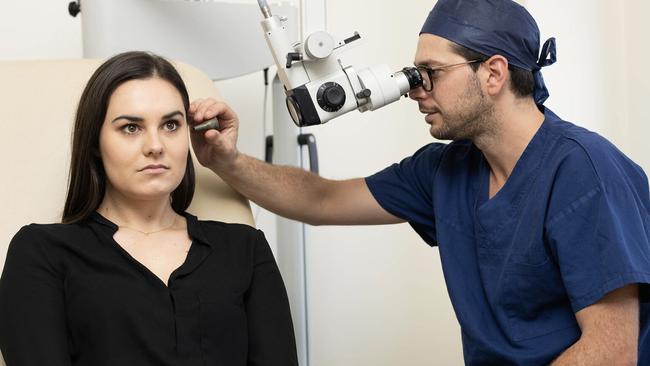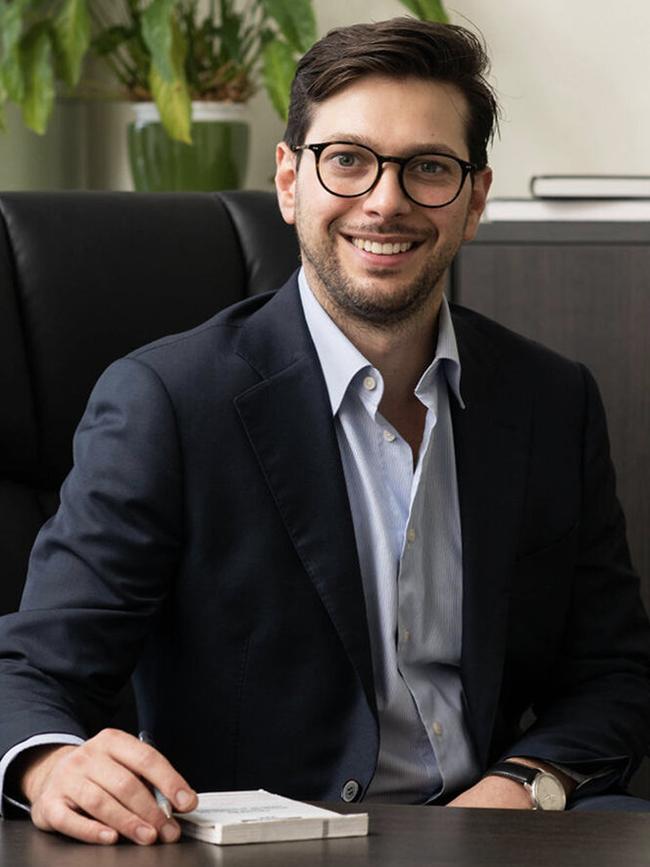They’re lifelike and efficient platforms growing in use: welcome to the world of AI health
Australia has been slower to take up AI tools in healthcare. But with an ageing population and a health workforce under pressure, doctors are seeing the benefits of artificial intelligence.
They’re lifelike, inquisitive and soon may be calling to check up on your post-surgery recovery.
Take the US company Hippocratic AI. It has developed a platform of AI healthcare assistants, each specialising in a subsection of healthcare, which can converse with a patient.
There’s Carlos, who can answer your questions about flu vaccinations, talk through the pros and cons for your situation, and help to book an appointment near you. Then there’s Julia, a post-op general surgery check-in assistant.
Julia calls patients, identifies herself as being AI, then holds a conversation with the patient, responding in real time to how they say they are feeling, and runs through a checklist of how they should be managing their care at home.
The only real giveaways that they are not human are their model-like profile photos and overly caring and enthusiastic responses delivered with a strange emphasis on certain words.
While the rollout of similar AI platforms has been slower in Australian healthcare than other parts of the world, its use is increasing. You probably already have chatted with an AI assistant when making an appointment or dialled a switchboard.
The future of AI is boundless and its potential benefits in healthcare seem obvious when you consider we are grappling with workforce pressures and an ageing population. It is already being used to triage calls, help to review medical imaging and tests, and chatbots are even being used in early-stage mental health interventions, with robots roaming the floors of some aged-care facilities.
Some recent studies also have found AI useful in detecting early-stage cancers far sooner than traditional screening methods. It is also helping doctors deliver care remotely, especially to people who live in rural or remote areas and paving the way for the creation of “virtual hospitals”. It is also helping to advance precision medicine.
Even the Cancer Research Institute has described the efficiency of training an AI tool to scan medical images for disease diagnosis as “promising”.
“Despite its potential challenges, AI is likely here to stay. It’s making waves in cancer research, and its potential to take us one step closer to a cure is incredibly promising,” the institute notes.
“With a heavy focus on safe adoption and ethically friendly practices, we may be on the verge of a medical revolution as significant as the development of the first vaccines.”
It is uses such as these that show the ability for AI to complete more mundane, repetitive and non-clinical aspects of care that could free up practitioners to spend more time with patients. That also has been a focus area for the government, which in 2024 amended the legislation to expand the prescribing powers and scope of care of nurse practitioners and endorsed midwives to try to ease pressure on the primary health sector.

For ear, nose, and throat surgeon Marco Raftopoulos, the advancement of AI is a welcome relief. When a patient arrives at his consultation room, he informs them he is using an AI scribe platform. If the patient consents, the technology then listens to their consultation, writes up case notes for Raftopoulos to review, highlights key words he needs to pay particular attention to, and can write referral letters.
“Sometimes you don’t necessarily hear everything the patients say or you miss stuff, but the AI doesn’t; it hears everything along the way. So, it will pick up on details that perhaps you didn’t quite catch during the conversation,” Raftopoulos says.
“From a clinic point of view, it’s about efficiency. Like efficiency, efficiency, efficiency; I now run to time. I just run to time, because I simply finish my consultation with the patient, and that’s it, I go and see the next patient.”
Raftopoulos uses a scribe platform that has been designed for his specialty. It means the technology is trained to recognise words unique to his area of focus. It’s the brainchild of Australian start-up Medow Health. Its founder and chief executive is Joel Freiberg, and he and his team have created a series of specialty-specific scribes.
“My dad is a lung specialist in Sydney and my background is in technology, so that’s where this intersection started,” Freiberg says.
“Many specialists are spending their weekends on reporting, staying until 10pm, and many are actually sacrificing the quality of the reporting because they just do not have the time to devote to it, which has real impacts on the patient.”
Traditionally, doctors would write up patient notes at the end of each appointment or dictate into a recorder and have their notes typed up at the end of the day or week. They would then review the notes and send out appropriate paperwork to specialists and GPs, but that could take several days.
With AI scribes, those documents are now ready for review in less than a minute of the consultation ending.
“The tolerance for errors in an industry like healthcare and specialist doctors is incredibly low,” Freiberg says.
“The time it takes to load the reports for us, we could be quicker, but the reason it’s taking 20 seconds is because we are checking and rechecking everything that gets produced to make sure the quality is as high as possible. And it’s getting better and better month on month.
“But again, as we say to all our doctors, it is a tool to assist the doctor, not replace the doctor.”

Sandeep Reddy is head of discipline for healthcare management and health information management with Queensland University of Technology and he sees the benefits of AI in health.
“It’s estimated about 25 per cent of our GPs here in Australia are using AI scribes,” Reddy says.
“Obviously there needs to be a formal study to validate that, but it is clearly increasing. One benefit is that it improves administrative efficiency. The second benefit is it allows more time for the general practitioners or the clinicians to spend more time with the patients.”
However, he points out the technology also deals with sensitive patient data that needs to be handled with care and attention. It’s a point underpinned by recent data breaches, including that of IVF giant Genea, in which sensitive patient data was stolen and sold on the dark web.
“I’m not aware of data that has been utilised for AI scribes being breached and being available on the dark web,” Reddy says.
“But that’s a possibility that we need to consider. It’s a requirement for the healthcare provider, as per the notifiable data breach scheme, to inform the Office of the Australian Information Commissioner if there were any breaches in the data.”
It’s a sentiment backed by Jake King, head of security and threat research at Elastic Security.
“AI is emerging so rapidly and it’s specifically emerging in industries that are very knowledge heavy,” he says. “So, if you’re in an industry that requires a specific set of very broad knowledge, legal, technical and software engineering capability based research … AI has been seeing explosive growth.”
While he considers that growth to be “exciting”, he acknowledges it carries risks and says those using it need to be aware of their responsibilities.
“It’s appropriate to look at this in the same way as any generative AI technology,” he says.
“These have serious implications to consumer privacy, patient privacy, in many different cases, and it’s important that those responsibilities are held to those making technical decisions to use these tools. So, I think having serious repercussions around the abuse of that information on the use of different services is important too.”
It is also a practitioner’s responsibility to inform the patient when AI is in use and the patient has the right to refuse its use.
Elastic Security has examined early threats within generative AI more broadly, finding over-reliance on the technology (where a user trusts the technology output with little scrutiny) appears to be more of a threat than an actual external cyber attack.
“Over-reliance is most dangerous when combined with hallucinations or confabulations, as the AI system creates unrealistic or misleading responses and presents them as facts,” the report notes.
Freiberg says Medow is aware of the vulnerabilities involved in healthcare data and has taken steps to protect it. He says all data is stored on Australian servers and only after the information has been de-identified and encrypted.
“We’ve partnered with Microsoft in Australia for our infrastructure and servers, and that’s because of their enterprise-grade security,” he says.
“So, it’s not like a patient’s data is going to train an AI model in San Francisco or anything like that. It’s housed in our secure server on our model, and all patient data is de-identified.”
But it is the unofficial use of other types of free AI platforms by practitioners more broadly that has people such as Reddy spooked. He suspects some clinicians are using programs such as ChatGPT beyond just administrative purposes, perhaps without realising the implications.
“That’s where I think there are serious violations of ethics because you’re uploading information to overseas servers, you’re breaching the relevant legal legislations or legal frameworks, but also you’re allowing for the data to be training the overseas-based large language model speakers.”
He says that’s where regulators need to be proactive and work alongside medical bodies and colleges to ensure the industry is educated and compliant with legislation and ethical expectations.

For the here and now, Raftopoulos says the benefits are obvious. He is more efficient with his time in the clinic, able to see more patients, and even gets home in time for dinner.
“I’m not wasting two minutes, five minutes or whatever at the end of each case, trying to remind myself of what I’ve just seen and spoken about,” he says. “It allows me to then move steadily through the days and then leave, with all my work completed.
“I’ve got three kids, I’ve got a fourth on the way, I need to get home.”





To join the conversation, please log in. Don't have an account? Register
Join the conversation, you are commenting as Logout